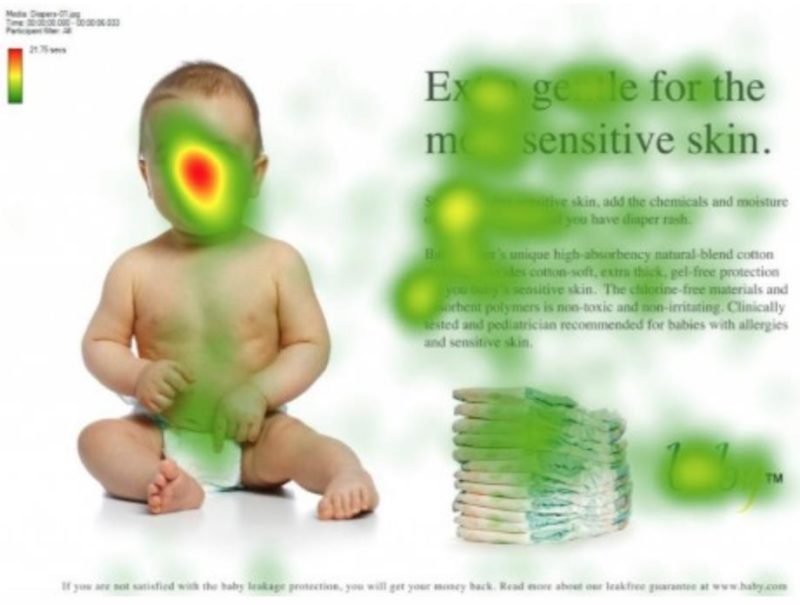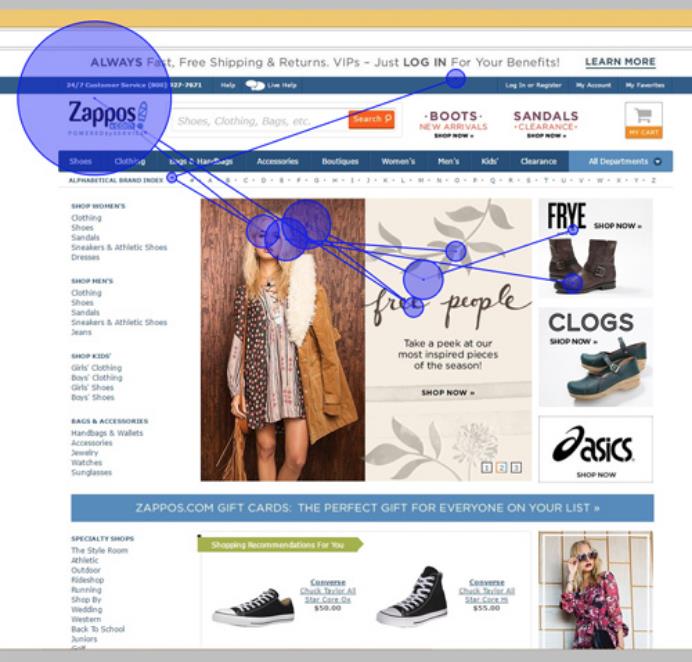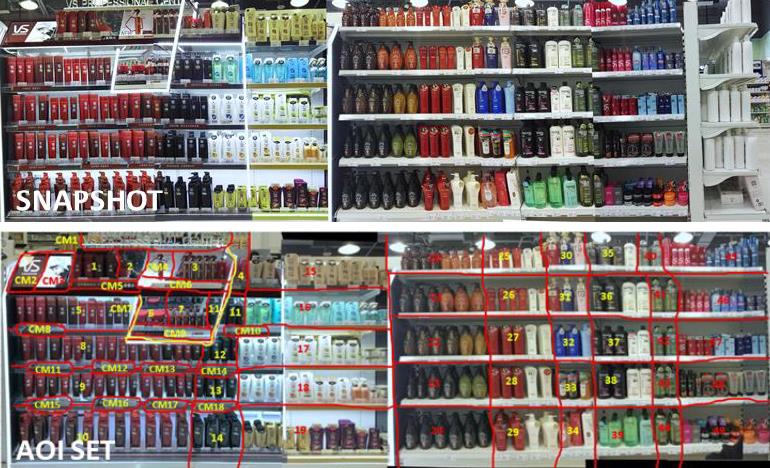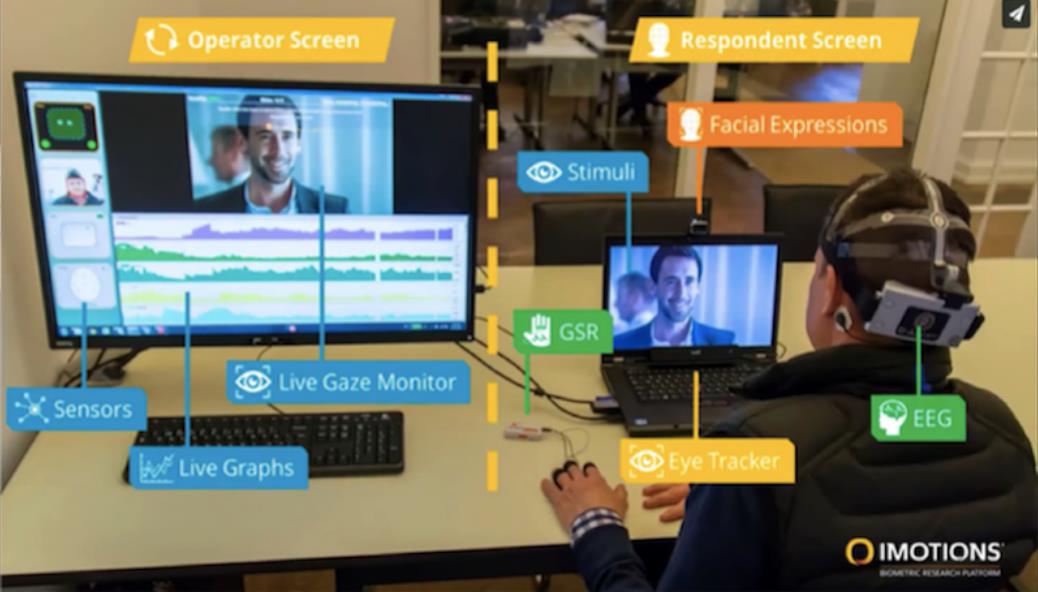Eye tracking at first glance
Eye tracking, first employed in the psychological research of study human cognition many years ago, has emerged in many different areas to provide more objective details for researchers and developers. The eye-tracking technology is used to track the eye movement, gathering information such as the focus level and attention span of humans. Furthermore, eye-tracking devices do not impede on the natural behavior of the subject in any outdoor or indoor space, enabling the researchers to understand what their intensions are towards certain products or circumstances.
The Chinese market function differently from the rest of the world and China dictates its own market rules. Despite the difficulties, many companies and entrepreneurs strive to become part of the Chinese market. Eye tracking grants insight to companies, allowing them to better understand the behavioral characteristics of Chinese consumers in the Internet space.
Thus, Daxue Consulting leverages the eye tracking methodology to study Chinese consumers. It has especially been a key method for international brands looking at testing, validating and, when needed, identifying the quick fixes in their packaging adaptation or their online China-focused user interface design.
On a global scale, eye-tracking is on the rise due to technological advancements. According to MarketsandMarkets, the eye tracking market is expected to be valued at USD 1,376.5 Million by 2023, growing at a CAGR of 27.4% between 2017 and 2023. Healthcare and research labs vertical held the largest share of eye tracking market in 2016. The eye tracking market in this vertical is largely driven by the need for assistive communication for physically impaired people and the need to understand and model the human behavior. Market research and consumer insights are the next fields of application in which the eye-tracking methodology has acquired significance. “Many companies in China’s market, both domestic and international, have leveraged the eye-tracking technology to do shelf testing, ads design and many other commercial research, which all benefit from it.” said by a salesperson in Tobii China, a branch of an international eye-tracking firm with branches focused on the Chinese market.
How to conduct eye-tracking with Chinese consumers?
When it comes to the Chinese market, the hardware and software vary with respect to the various applications of eye-tracking, different types feature different strengths for different research objectives. In order to be compatible with each other, software and hardware are always bundled together to be developed and sold by unique companies. Most of the solutions we will detail below are not limited to the Chinese market, while the main solution leveraged by Daxue Consulting to provide eye-tracking applied to Chinese consumers to international brands.
The solution for eye-tracking in China: Hardware
3 types of eye trackers are usually leveraged in China to extract the required data. It includes screen-based eye trackers, glasses and webcams. All need different softwares, so as to analyze different input.
- Screen-based eye tracker
One type of three main eye trackers—screen interfaces (computer, laptop, tablet, mobile), can be tested with other devices to understand the behavior, the perception, the attention and the interest of the participants toward a digital offer. In such cases, the system uses cameras mounted underneath the screen. These cameras are well concealed on the most cutting-edge devices that the research participant doesn’t even notice. This type of eye tracker tends to be operated in the remote distance. In China, its applications include research for sectors or such as digital marketing or game designs.

- Eye-tracking glasses
Glasses for eye tracking is to be used for similar insight extraction than the screen-based eye-tracker in China, while the choice of its usage will usually be done according to the type of experience testing and available budget. Glass eye-tracker will add another caveat on the context immersion of the participants, while offering a more competitive solution providing the same set of data (with, again, the bias of user being less immerged into the experience and less comfortable with the device).
- Eye-tracking webcam
While being the most competitive option, webcam eye-tracker in China is not able to be as robust and accurate as its two eye-tracking counterparts in China, but further development could improve the performance. The practical advantage of webcam eye-tracker is its remote operation as well as more natural measurement.
The solution for eye-tracking in China: Parameters setup
The price of different eye trackers in China differs vastly on account of three basic parameters of movements detection, which are measurement precision, sampling rate and headbox size.
- Measurement precision
Measurement precision is a crucial factor in eye movement research in that low accuracy may lead to lack of accurate data to gain valuable insights. Accuracy should comply with the research purpose. High accuracy is around 0.1 degree, most likely being desired in more advanced commercial or academic research. Standard is about 0.5 degree and low accuracy starts at around 1.0 degree.
- Sampling rate
Sampling rate measures how many times per second the eye position is captured by the eye tracker, high of which undoubtedly improves the test results. Typical value range in the offer available in China is 30-60 Hz. Some products, however, such as EyeLink 1000 Plus can reach up to 2000Hz.
- Headbox size
Headbox size, though not as important as two former industry benchmarks, would affect subjects’ movement freedom range during screen-based eye-tracking research. A large headbox size would give respondents a more interface-friendly experience.
| Two types of eye trackers prevalent in the market (wearable eye tracker; screen-based eye tracker) | |
What analysis is driven by eye-tracking data collection in the Chinese market by Daxue Consulting
Chinese consumers are becoming pickier on perception and purchase of products especially when products are available in different channels. Particularly, millennials pursue high life quality with increased disposable income and mostly are the audience of TV and online advertisements. Therefore, subtle package design and advertisement testing, for instance, could be impactful factors in China’s market. Eye-tracking, thus, can be leveraged by companies to optimize customer experience in Chinese digital environment. Here we can have an eye on some major analysis methods embedded in the eye-tracking software.
- Fixations describe where one person is actually looking at, whether consciously or subconsciously. Daxue Consulting usually leverages this method to complement in-depth interviews which, will providing more rationales into preferences, can be subjective and be impacted by specific cognitive bias. Fixations, on the other hand, could reveal where the respondents’ attention truly is as eyes reflect intensions in most cases. The software of the eye tracking devices analyses the duration of each gaze spent on the various parts of certain objects and ads and so forth. Using this data, the program determines the attention level, generating hotspot images (heat maps) to illustrate the degree of visual attention.
- Heat maps serve as an excellent method to visualize which elements of the stimulus were able to draw attention – while red areas suggest a high number of gaze points and therefore an increased level of interest, yellow and green areas point toward flattening visual attention.

- Gaze path is another commonly used method to facilitate eye-tracking analysis. Not only the fixation spots on the interface are relevant but also where the users look for the information at the first and second fixation, and what path their gaze travels while searching for certain information need to take into account. It is also worth noticing that the wandering of the gaze always relates to some actions, so it’s of the same significance taking into account the relations of previous, current and next eye motions of the participants when analyzing their behaviors. Also, separating respondents into groups according to research purpose and then aggregating gaze paths could obtain valuable consumer behaviors. By comparing the obtained results, researchers are able to understand which one of the images and arrangements is the most efficient. Another important analysis is to determine when the participant’s gaze returned to a specific component on the interface. If it has happened on several occasions, Daxue Consulting usually conducts follow-up interviews with the test participants to discuss their experiences. Although no one is able to recall their eye movements, useful information can be obtained by discussing and analyzing together what they saw.

- Areas of Interests (AOIs) is defined as user-defined sub-regions of a displayed stimulus. Researchers select attention areas consistent with the research purposes, during the experiment the audience only focuses on these areas. In general, there are two ways to measure AOIs: dwell time and fixation count. Dwell time describes the total amount of time a participant fixates or simply glances with an AOI. A respondent count is another metric to test hypotheses by gauging how many of respondents actually guide their gaze towards a specific AOI. In essence, AOIs could provide a more detailed analysis concerning the comparison of groups which includes participants, conditions, or different features within the same scene.


Price comparison for eye tracking in China
Due to different research purposes and analysis methodologies, the price of eye-tracking business in the Chinese market (most of them combine hardware and software) varies. According to Daxue Consulting experience, the competitively of the applied solution is an important aspect of the set up for international brands, and the market research purpose usually does not require the highest accuracy.
The eye-trackers showed below are available in China, except Tobii having its branch in China, the remainder being sold by Chinese distributors.
- Low-end eye trackers
The price range of this category is from 700-7,000 RMB. Eye trackers at this price range are either hardware sold without software or not research-focused hardware.
- GazePoint GP3 – 60 Hz (hardware only)
- Tobii EyeX (Works with Tobii Gaming SDKs – not for research purposes)
- Tobii 4C (Works with Tobii Gaming SDKs – not for research purposes)
- EyeTribe (acquired by Oculus / Facebook)
- Middle-end eye trackers
The price range of this category is from 7,000-100,000 RMB. The eye trackers within this price range are, for certain research questions, more than adequate and provide good value for those with a limited budget.
- GazePoint GP3 HD 150 Hz
- Tobii X2 – 30 Hz
- SMI RED M (SMI Acquired by Apple)
- EyeTech VT3 mini – 40 / 60 Hz
- EyeTech VT3 XL
- Mirametrix S2
- Pupil Labs glasses
- aSee Pro 90Hz
- High-end eye trackers
The price range of this category is beyond 100,000 RMB. In this section, you will find the top-of-the-line eye trackers available for commercial and academic use. Eye trackers of this caliber are normally used by organizations with more advanced research objectives that rely heavily on high accuracy, precision, stability, and usability.
- Tobii T60 XL – 60Hz
- Tobii Pro Spectrum – 150 / 300 / 600 Hz
- Tobii Pro Glasses 2
- aSee Pro 140Hz
- Seeing Machines faceLAB 5
- SMI RED-m – 60Hz / 120Hz (SMI Acquired by Apple)
- EyeLink 1000 Eye Tracker – 500 / 1000 / 2000Hz
- LC Technologies EyeFollower
- Smart Eye Pro Eye Tracker – 60Hz / 120Hz
- Smart Eye Pro dx
- Ergoneers Dikablis Professional Glasses – 60Hz
- Smart Eye Aurora – 60 Hz
- Tobii X2-60
Takeaways of eye-tracking application
When it comes to market research application of eye-tracking in China, increasing attention and case study has to be made. The application of eye tracking can cover many areas, among which include website layout, advertising and marketing development, package designs and product designs in China. Eye tracking has the unique advantage of providing objective feedback to the designer so that costly mistakes can be avoided.

More examples of big companies from different industries leverage eye tracking studies alone or in combination with other biometric studies to help troubleshoot defective products, improve the ROI of ads, better understand consumer behavior, etc.
Development: how to follow-up eye-tracking with more neuro-marketing and emotion evaluation methodologies in China
It is widely believed that the eye-tracking technology is becoming one of the most crucial components of neuromarketing since it’s not strictly constrained by environmental factors and it reveals direct and easy-to-analyze participant reactions. Thus, combined with other biometric sensors, eye tracking is expected to be much more powerful. Sometimes eye-tracking can be combined with other biometric sensor-based methodologies. Here are below 4 examples of potential methodologies leveraged in China:
- Facial Expression Analysis: Facial expression analysis is a non-intrusive method to assess both emotions (subconscious reactions prior to feelings – typically small movements in face muscles) and feelings (conscious reactions occurring after emotions – typically more visible muscle movements).
- EEG: Electroencephalography is a neuroimaging technique measuring electrical activity on the scalp. EEG tells which parts of the brain are active during task performance or stimulus exposure. Analyze the brain dynamics of engagement (arousal), motivation, frustration, cognitive workload and other metrics associated with stimulus processing, action preparation, and execution. EEG provides the quickest response of all biometrics sensors
- GSR (EDA): Galvanic skin response (or electrodermal activity) monitors ”emotional” sweat secretion on hands or feet. Skin conductance offers insights into the respondents’ subconscious arousal when being confronted with emotionally loaded stimulus material.
- EMG: Electromyographic sensors monitor the electric energy generated by bodily movements (e.g., of the face, hands or fingers). Use EMG to monitor muscular responses to any type of stimulus material to extract even subtle activation patterns associated with emotional expressions (facial EMG) or consciously controlled hand/finger movements.

For now, eye tracking is certainly a worthwhile investment for brands keen to better understand and engage Chinese consumers in a variety of ways (packaging, user interfaces, marketing campaigns). By introducing eye-tracking in neuromarketing research, international businesses could resort to a cross-cultural and full-covered observation system, potentially being more attractive to Chinese consumers with a full data-driven understanding.
Author: Will Qian
Eye-tracking in China is a useful tool to optimize the way people interact with your website. But it is important to remember that the goal is not to get them to see anyone specific part of your page or to follow any particular path – the goal is to convert them. This is Daxue Consulting’s primary focus when using eye-tracking software.




